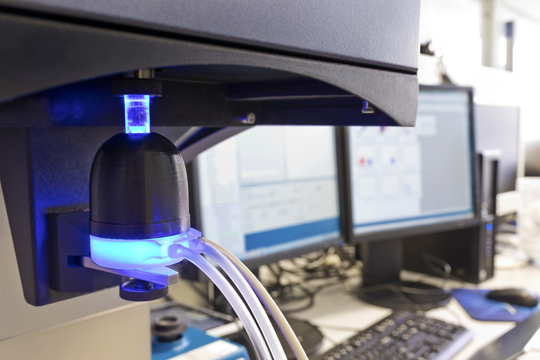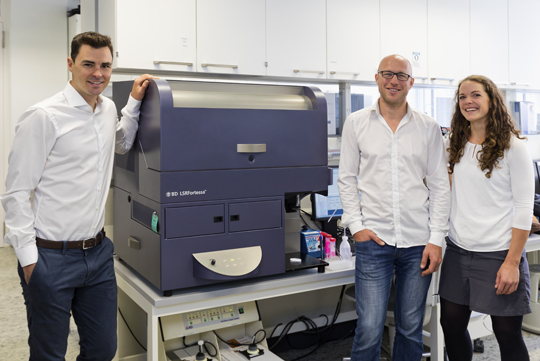Illuminating Cells, Instead of Cooking Them
Freiburg, Nov 09, 2018
Optogenetics has brought huge advancements to biological and medical cell research. A new spinoff from the University of Freiburg called opto biolabs has developed an award-winning illumination module that allows scientists to evaluate optogenetic experiments one thousand times faster than with conventional methods. This could shorten the time needed to develop new health treatments or biofuel, for example.

The light source created by opto biolabs allows scientists to characterize a greater number of optogenetically altered cells according to more criteria in less time than before. Photo: Jürgen Gocke
Illuminating cells in a controlled manner, instead of cooking them to death, is not the only thing that scientists find impressive about the illumination module pxONE. The startup company opto biolabs based in Freiburg also won the CyberOne Hightech Award Baden-Württemberg in the category Life Science & Health Care in September 2018. “Optogenetics is about using light to control cells remotely,” says Dr. Kathrin Brenker, who is the head of research & development at opto biolabs and has an M.A. in molecular medicine and a Ph.D. in biology. Brenker started up opto biolabs this spring together with Dr. Dirk Riemann and Raphael Holubarsch. The light source developed by opto biolabs, pxONE, allows scientists to characterize a greater number of optogenetically altered cells according to more criteria in less time than before. Thanks to pxONE, the relatively new field of optogenetics is gaining momentum, also boosting biological and medical cell research.
Protein Light Switch
How does this work? To put it simply, optogeneticists first install a light-sensitive switch on proteins. These switches can then be controlled by light. If the protein is an ion channel, then it can be opened or closed as needed. With these light switches installed on certain ion channels in the outer membrane of nerve cells, researchers can activate neurons specifically: Turn the light on and the nerve cell becomes active and “fires,” sending out an electric impulse; turn it off and the cell stops. As a result, scientists are able to examine the functions of neurons as well as their network processes in much closer detail. “We can now also use light to regulate proteins inside cells,” Brenker says, meaning that researchers will now be able to study the function of certain cell proteins and the role they play in intracellular signaling, for example.
Thanks to these benefits, optogenetics has become an important tool in biological and medical research. The techniques of illuminating optogenetic cells have been slow to develop, however. “Most researchers are still working with flashlight-like sources of light,” Brenker says. However, these devices don’t illuminate the cells homogeneously. Different light intensities and times are also difficult to standardize. What is more important, the light causes the cells to heat up. “Many scientists virtually cook the cells by accident,” Brenker says. Having worked with such optogenetic methods herself, she knows what she’s talking about. The pxONE solves these problems by keeping cells at a constant, predefined temperature as it illuminates them. Scientists can set the time, light intensity, and wavelength with precision. The settings and data are also saved, allowing researchers to repeat the process exactly at any time.

Raphael Holubarsch, Dirk Riemann, and Kathrin Brenker (left to right) formed the startup opto biolabs in the spring of 2018. Photo: Jürgen Gocke
Innovation Born Out of Dissatisfaction
The greatest gain for optogeneticists is increased efficiency. The pxONE indirectly allows them to characterize optogenetically modified cells one thousand times faster than before. In order to do this, scientists must first make these cells recognizable and distinguishable from other cells. “They color optogenetic cells with a fluorescent dye,” Brenker says. A short laser pulse then causes these marked cells to glow or fluoresce. The following analysis of the cell cultures is done more or less by hand using a fluorescence microscope, or it is done automatically using flow cytometry. In the latter, single cells flow by a laser beam in a flow cytometry instrument. A detector inspects each cell to determine whether it radiates light. If it does, further information is provided, such as cell size. The instrument also renders these and other characteristics as graphs. Brenker is familiar with both methods: “With a fluorescence microscope, I can analyze roughly 50 cells per minute; with flow cytometry I can do 20,000 per second.”“
The problem with optogenetic flow cytometry until now was that flow cytometry instruments have no light sources for conducting optogenetic experiments. Brenker has struggled with this in the lab herself. “I had to work a lot with a fluorescence microscope in a dark room at 18 degrees Celsius, while outside it was warm and the sun was shining.” She wanted to step back out into the light and go back to flow cytometry. Her dissatisfaction with her situation turned out to be productive, when she designed a light module that can be combined with a flow cytometry device. She then took her idea for the predecessor of pxONE to the technology working group at the Institute of Biology III. “We developed the first prototype as a team,” she says. Today, opto biolabs professionally manufactures the entire light module – controller and all – using a 3-D printer. pxONE is expected to receive CE approval by the end of 2018, and in the meantime, the company Ernst Knoll Feinmechanik GmbH in Umkirch has been helping the opto biolabs team.
Climbing Brought the Team Together
The three partners got to know each other while doing sports. “We met while bouldering,” Brenker says. At the time, her EXIST startup funding had been approved, which the Entrepreneurial Office (Gründerbüro) at the University of Freiburg had helped her with, and she was looking for partners. Then one day while bouldering (climbing without a rope or harness) in the gym, she told her friends excitedly about getting approval for an important patent for pxONE. Riemann and Holubarsch overheard her and became interested. Riemann, who is a climatologist, physicist, and geographer, is now the head of technology and production, while Holubarsch, who has an M.A. in management, is the head of finance and operations. “We’re not founded yet, however,” says Brenker, because the team has applied for follow-up funding from the Junge Innovatoren (Young Innovators) program, which they could not have done as an “official” company.
“We expect to launch on the market in the beginning of 2019, which means we have a lot of work ahead of us,” says Brenker. For the moment, the three partners are currently lending the pxONE prototypes only to cooperation partners. “Two pilot customers are already working with it,” says Brenker. Both are research institutes, one in Freiburg and one in Berlin, and opto biolabs will use their feedback to optimize the next prototypes. After that, the next step will be to find a production partner, and then conquer the market. Brenker has many hopes for pxONE – that it will help to speed up the development of new treatments for disease and the development of new organisms to produce biofuels or break down waste, for example. In the near future, researchers wanting to try optogenetics for the first time should look at opto biolabs to see how to do it right, Brenker says. “I think it would be wonderful if we became a byword for illumination devices in optogenetic research.”
Jürgen Schickinger

